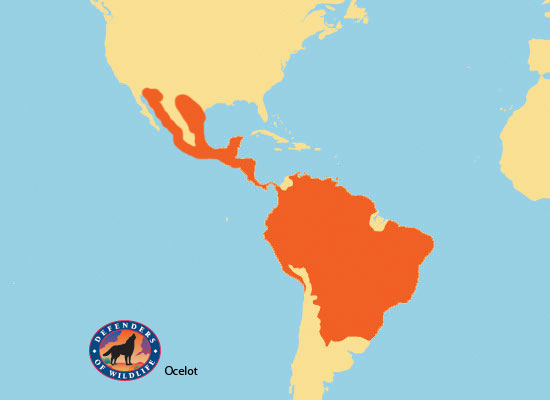Aaron Capinpin
Ocelots
Description and Ecology of Ocelots
 |
| (From Source 2) |
The ocelot (Leopardus pardalis) is a medium sized cat that is also solitary and territorial. Ocelots may weigh from 7-16 kg. The spots on the ocelot’s body are shaped like unlinked chains. As you look lower on the ocelot's body, the spots become more circular. Also located on the ocelots face and neck are vertical stripes. On its tail there are rings of black that may or may not fully reach around its tail.
 |
| (From Source 3) |
Ocelots are a generalist species. This means that they have the ability to eat a wide variety of other species. So, when an ocelot hunts it may hunt from trees, the ground, or in water, eating either fish, birds, or other mammals. The ocelots are usually nocturnal and are active 12-14 hours per day. During the daytime, they rest in brush piles, clumps of vines or in between the roots of large trees. When ocelots are not hunting, their movements become cryptic. Many researchers still do not comprehend the patterns of the ocelot’s activity.
Geographic and Population Changes
 |
| (From Source 4) |
Listing Date and Type of Listing
The ocelot was listed as endangered in 1972 under the authority of the Endangered Species
Conservation Act of 1969 (Source 1).
Cause of listing and Main threats
Like many other endangered species, the ocelot faces similar threats: habitat loss and fragmentation. The main sources of these two are from the need of the agriculture industry for farmland and the construction of new roads. This duo causes the ocelots to separate; separation in turn leads to loss of genetic diversity and a decrease in the ocelot population. Along with that, roads are dangerous for another reason: vehicles. Cars threaten ocelots by turning them into roadkill. Another threat to the ocelots are humans. In the mid 1900s, ocelots were being killed illegally. Humans sought ocelot pelts, especially those in the fashion industry of the time. Also, ocelots were being taken from the wild to become pets.
Recovery Plan
The objective of the plan is to withdraw the ocelot from the list of threatened and endangered species by ensuring the ocelot population's lasting survival through the revitalization and protection of the ocelot populace and protection of their habitat. The steps needed to achieve this goal are:
1. Estimate the necessary habitat space required and safeguard that habitat so that it may maintain a reasonable population of ocelots in the border region between the U.S. and Mexico.
2. Curb the effects humans have when developing on ocelot habitats.
3. "Maintain or improve genetic fitness, demographic conditions, and health of the ocelot"(Source 1).
4. "Assure the long-term viability of ocelot conservation through partnerships, the development and application of incentives for landowners, application of existing regulations, and public education and outreach"(Source 1) .
5. "Practice adaptive management in which recovery is monitored and recovery tasks are revised by the USFWS in coordination with the Recovery Team as new information becomes available"(Source) 1).
6. "Support international efforts to ascertain the status of and conserve the ocelot south of Tamaulipas and south of Sonora"(Source 1).
1. Estimate the necessary habitat space required and safeguard that habitat so that it may maintain a reasonable population of ocelots in the border region between the U.S. and Mexico.
2. Curb the effects humans have when developing on ocelot habitats.
3. "Maintain or improve genetic fitness, demographic conditions, and health of the ocelot"(Source 1).
4. "Assure the long-term viability of ocelot conservation through partnerships, the development and application of incentives for landowners, application of existing regulations, and public education and outreach"(Source 1) .
5. "Practice adaptive management in which recovery is monitored and recovery tasks are revised by the USFWS in coordination with the Recovery Team as new information becomes available"(Source) 1).
6. "Support international efforts to ascertain the status of and conserve the ocelot south of Tamaulipas and south of Sonora"(Source 1).
What can you do?
Be Aware! Support the cause here :
https://support.worldwildlife.org/site/SPageServer?pagename=donate_to_charity
Other Resources
Wanna look at cool ocelot pictures?
Look here http://animals.nationalgeographic.com/animals/mammals/ocelot/
Wanna look at even more ocelot pictures!?!
Look here http://twistedsifter.com/2011/12/adorable-ocelot-30-pics/
Works Cited
1. Service, U.s. Fish & Wildlife. "Recovery Plan for the Ocelot (Leopardus Pardalis) First Revision." (n.d.): 1-237. July 2016. Web.
2. "Ocelot." FELID TAG. N.p., n.d. Web. 28 Nov. 2016. <http://felid-tag.org/ocelot/>.
3. "News Releases." Rainforest Rodents Risk Their Lives to Eat | Newsdesk. N.p., n.d. Web. 28 Nov. 2016. <http://newsdesk.si.edu/releases/rainforest-rodents-risk-their-lives-eat>.
4. Https://www.facebook.com/DefendersofWildlife/. "Basic Facts About Ocelots." Defenders of Wildlife. N.p., 14 Oct. 2016. Web. 28 Nov. 2016. <http://www.defenders.org/ocelot/basic-facts>.
3. "News Releases." Rainforest Rodents Risk Their Lives to Eat | Newsdesk. N.p., n.d. Web. 28 Nov. 2016. <http://newsdesk.si.edu/releases/rainforest-rodents-risk-their-lives-eat>.
4. Https://www.facebook.com/DefendersofWildlife/. "Basic Facts About Ocelots." Defenders of Wildlife. N.p., 14 Oct. 2016. Web. 28 Nov. 2016. <http://www.defenders.org/ocelot/basic-facts>.
Wow! Interesting that the ocelet ranged into Texas, I didn't know that. Is the 100 ocelets in the USA due to them being killed by humans and habitat destruction or is it just because their range is so small in the US?
ReplyDelete(Brian Cheuk Chan)
ReplyDeleteThe ocelot has such an interesting history and wide range. I find it also bizarre that the animal has such a huge population worldwide but is small in America; causing the animal to be listed. However, I don't necessarily know if this permits such a large attention to this animal if there are more animals at a lesser worldwide number. This animal still has a buffer zone before it is truly critically endangered. Other than that, this was a splendid read.